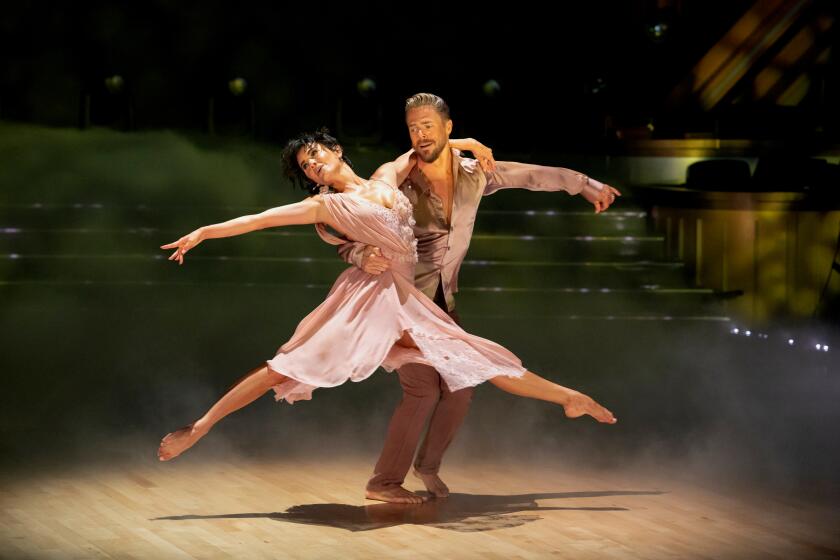MUSIC REVIEW : Long Beachâs Falletta Closes Bay Area Series
SAN FRANCISCO â With the annual national conference of the American Symphony Orchestra League in town last week, the orchestras of San Francisco lined up to display their wares in a series of stimulating and celebratory concerts.
The sequence began Wednesday evening when Nicholas McGegan and the Philharmonia Baroque Orchestra presented a period-practice perspective on symphonies by Schubert and Beethoven--light, swift, and chillingly out of tune in the sweltering Herbst Theatre.
Thursday at Davies Symphony Hall, the conference host San Francisco Symphony played three conservative American short works under Neal Gittleman, Tsung Yeh and Marin Alsop--the participants in the Leagueâs 1989 American Conductors Program--and a cold, brassy Beethoven Fifth for Michael Tilson Thomas at his twitchiest.
The mettlesome and disciplined San Francisco Symphony Youth Orchestra under Leif Bjaland followed Friday at the First Congregational Church with a strong program devoted to contemporary composers with Bay Area connections.
The series climaxed in the conference finale Saturday. Under the assured conducting of music director JoAnn Falletta, the new leader at the Long Beach Symphony, the Bay Area Womenâs Philharmonic proved that it is as interesting artistically as sociologically.
Founded in 1980, the Bay Area Womenâs Philharmonic has already become a significant force in American symphonic music. At the conference the orchestra picked up its sixth ASCAP award for adventuresome programming of contemporary music, and co-founder and executive director Miriam Abrams won the Leagueâs Helen M. Thompson Award.
Though a community orchestra with a budget under $135,000 and a season of only four concerts, the Bay Area Womenâs Philharmonic has disproportionate artistic resources and impact. The string sections lack depth in numbers and raw talent, but are well-drilled and spirited, and the orchestra boasts several standout wind soloists.
In the boomy acoustic of the First Congregational Church, the orchestra sounded crisp and committed in a tidy retrospective that displayed the ensembleâs many virtues and some of the wealth of neglected music by women composers.
The program ranged over a wide historical and stylistic gamut, beginning with a Sinfonia in C by Marianne Martines, a contemporary of Haydn. In three movements with the pert charm and dark grace of Boccherini, it gave the BAWP strings their best opportunities.
Falletta enforced textural clarity and straightforward propulsion for the most part. Her ability to massage singing lines without deflating them found appropriate employ in the ensuing Siciliana from Amy Beachâs âGaelicâ Symphony, delivered with well-balanced ardor by her players.
A flair for explosive, brilliantly colored scores was apparent in the contemporary selections. Falletta & Co. turned out the three-movement âMusica Sinfonicaâ of Grazyna Bacewicz with piquant vigor, unduly brittle at times but alert to both the implicit dances and the quick flow of orchestral conversation.
Libby Larsenâs âOverture--Parachute Dancingâ provided an ideal vehicle for the orchestra, in its percussion-rich, solo-laden textures and sustained, dramatic, witty drive. It also calls for orchestral sections to stand up for fleeting solos, in an apparent big-band parody.
A contained podium presence of economical, pertinent gestures, Falletta guided everything with an ear for detail. She gave as much attention to commas as to exclamation points, keeping her obviously eager musicians under careful rein.
âDâun Soir Tristeâ and âDâun Matin de Printemps,â gorgeous but overly long exemplars of swollen Impressionism by Lili Boulanger, completed the program. Presented with missionary zeal and confident musicality for a uniquely influential audience, this concert might have a real impact on future programming around the country.
More to Read
The biggest entertainment stories
Get our big stories about Hollywood, film, television, music, arts, culture and more right in your inbox as soon as they publish.
You may occasionally receive promotional content from the Los Angeles Times.










